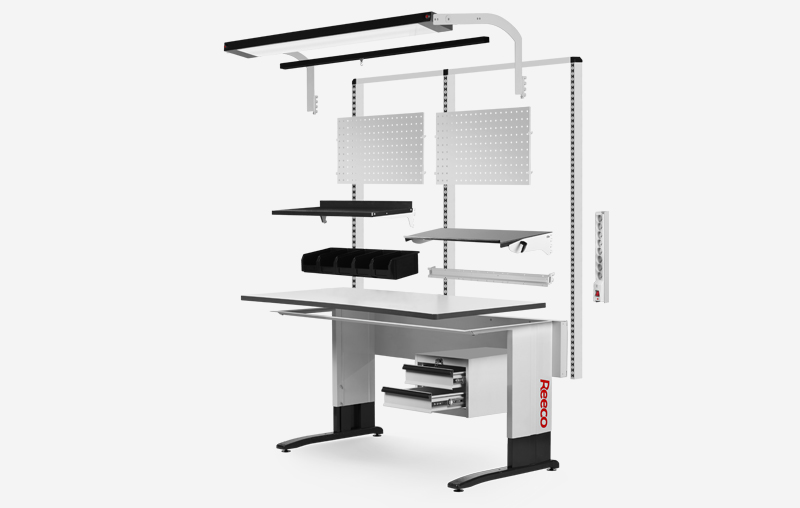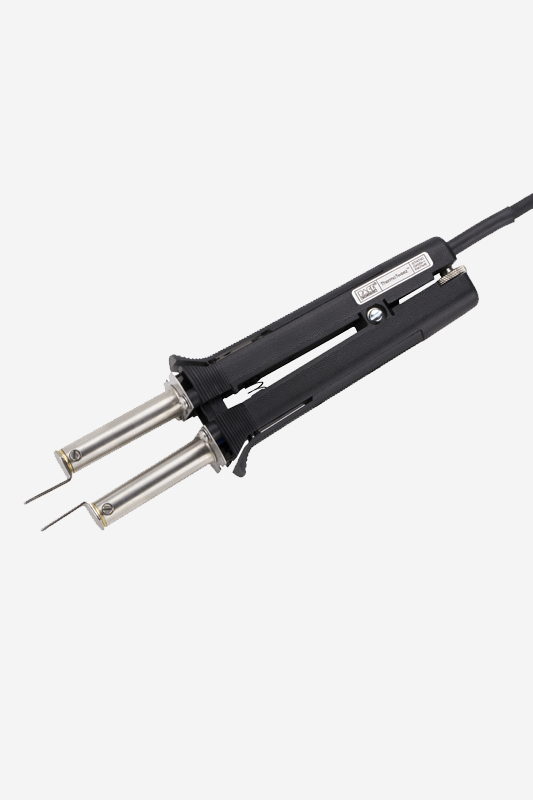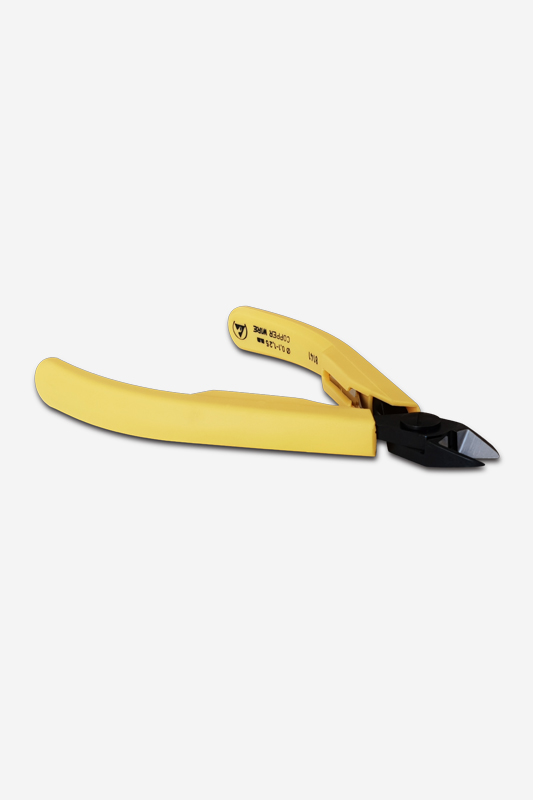Last month we made an attempt to collect and identify solutions to problems related to building a workstation for electronics from the ground up. What is left is to choose the devices, instruments, tools, accessories and materials used to perform technological activities necessary in production, laboratory or service processes.
In the previous part of the article, we discussed the problems facing
an electronics engineer, who wishes to select the basic, typical equipment of his/her workstation and its surroundings. Let us remind you that while completing the necessary equipment, we have chosen: antistatic esd table from the REECO offer (with a modular construction, allowing for any design of its configuration), ergonomic antistatic esd chair (REECO), set of cabinets and shelves (REECO), appropriate containers for parts.
We provided proper workshop lighting (Daylight), antistatic protection (3M), as well as harmful smoke and fume absorbers (PACE). Now comes the necessity of selecting and configuring the equipment for specific tasks carried out at the created workstation. In the research, manufacture and servicing of electronic devices, one of the most common operations is soldering and desoldering of components or units.
Depending on the scale and required efficiency of the process, the repeatability of its parameters, such as type of assembly, types and dimensions of elements, dimensions of printed circuit boards, etc., appropriate tools, devices or integrated systems are used – from simple soldering stations to highly efficient and precise systems designed for assembly or disassembly of all types of SMD elements and circuits.
Making the right choice requires confronting needs with the equipment available on the market. The potential opportunities can be seen in the example of PACE products (cf. article “Soldering” from EP9 and 10/2002). An important feature of PACE devices and systems is the possibility of selecting specialist handles and ends for them and the resulting openness to expansion.
Within the group of assembly/disassembly devices, including single and multi-channel soldering stations with built-in compressors (from ST75 to PRC2000, photo 1 shows a three-channel soldering station MBT250), it is possible to create a stand for: assembly and disassembly of THT and SMD elements, transfer and positioning of elements, dosing of soldering paste or flux, repair of printed circuit boards (including multi-layer ones), removal of protective layer from boards, removal of insulation from wires.
Auxiliary activities can be carried out by: smd tweezers, paste (or flux) dispenser, low-voltage handles and mini-drilling machine with a set of tips for drilling, cutting, cleaning and grinding. Available handles for assembly/disassembly are: soldering handle PS-90 (as many as 90 tips), suction handle SX-80 (30 tips), thermocouple TT-65 (45 tips – photo 2), thermocouple handle TP-65 (photo 3) and dualtermopik DTP-80 (11 and 10 tips respectively), thermojet handle (7 nozzles for hot air blowing).
The PS-90 handle is also standard in the PACE range of soldering stations ST25-ST55. If you need a precise, programmable, high-performance system for assembly/disassembly of all types of SMD components – choose ThermoFlo or TF2000. In some cases, especially at service stations, the Dic Den-On SC7000, equipped with an integrated compressor, is highly suitable for the extraction of solder and for hot air blowing. It allows for efficient disassembling of the THT elements (also from multilayer boards with metallized holes) and SMD elements and systems – both with heads and nozzles. If different tips are to be used on the stand, a convenient and safe way of storing them should be provided, preferably on suitable stands.
Handles also require the right stands. You can’t forget other necessary accessories such as filters and wipers for the suction handles and head cleaning kits. Tin wire with the right diameter, soldering paste, fluxes – these in turn are necessary assembly materials. At this point it should be noted that even when using a manual soldering iron, you can use an automatic tin wire feeder, which prevents skin contact with lead while increasing comfort. Manual tools will be required for the assembly/disassembly of electronic components and circuits, as well as for activities related to e.g. opening/closing device housings, preparation for assembly of components (pre-cutting and shaping of leads, positioning) and cables (cutting, insulation processing). Pliers, cutters, tweezers, screwdrivers and knives are the basic groups of tools always present at the electronics workstation. They should be characterized by accuracy, reliability, ergonomics, durability.
The user should remember that the best properties of a tool will become available when it is applied correctly. The number of working tips of the cutters or the variety of tweezers’ shapes indicate that they are intended for use in very specific situations and their skilful selection for application is very important. The secrets of quality are hidden both in the construction of the tools and in the materials and machining technologies used. For example, most tweezers are made of non-magnetic and acid-resistant materials. Nickel, nylon and Teflon-coated tweezers are available. Special types of steel are used for the production of cutters.
Shapes, proportions, weights are selected to ensure efficiency, safety and comfort. Workshop equipment is complemented by chemical agents used mainly for cleaning PCBs from grease, flux, adhesives, etc., cleaning surfaces of housings, screens, etc., cleaning and regeneration of switch contacts, potentiometer paths, diagnostics by rapid cooling etc. The comprehensive supply of such products and their accessories is provided by Micro Care. The products are usually available in containers that allow them to be sprayed.
However, if frequent use of chemicals is expected, it is necessary to equip the workstation with a special dispenser, equipped with a working tip, enabling the application of the agent exactly in the desired place and cleaning. Effectiveness, convenience and significant savings (up to 50%) of products are the profits associated with this investment. One of the eight brush tips or one of the three needles can be used with the dispenser. To ensure that the containers and the dispenser have their own fixed, well accessible place for the operator, special holders are provided for fixing them at a convenient point at the workstation. Since small things also play an important role in many jobs, we should mention cloths, wipes and swabs, which are excellent for efficient operation. The next area to be developed is the equipment for visual control of precise activities or quality control of the assembly, path repair or cleaning efficiency.
A suitable instrument or system should be selected, taking into account, among other things, the desired magnification value, resolution, type and dimensions of the tested objects, required additional functions, such as the possibility of documentation, economic conditions, etc. The various needs in this field can be satisfied by choosing a device from the Daylight (magnifiers) or Vision (optoelectronic vision systems) offer. If you plan to control the process of assembly or regeneration of BGA elements, you need to buy a special X-ray machine, e.g. PACE XR-2000. Is there still some space left? We will fill this space with electronic devices. Power supply, generator, oscilloscope, multimeter, RLC bridge – there are almost endless possibilities of selection and configuration of measurement and control sets for tests, diagnostics, activations etc.
Of course, in many cases we will start with this group, making the spatial organization of the workplace dependent on the functions related to measurements. In each specific solution, we will distribute priorities differently, but the resulting different proportions in terms of the number and “calibre” of devices and tools of a given type will not change the need to take into account the scope of the problems to be considered and resolved.


